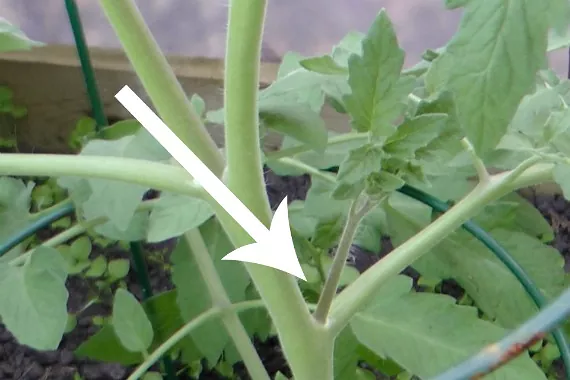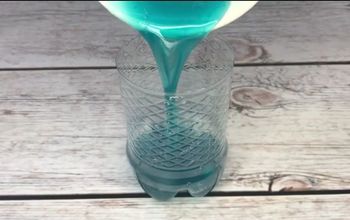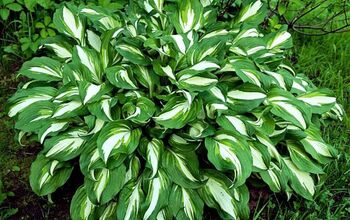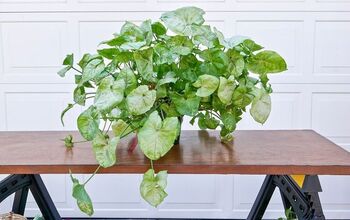How to Prune Tomato Plants for Your Biggest Harvest Ever

By Hannah Twietmeyer
When it comes to gardens, there’s a big difference between lush and overgrown greenery. Sure, those of us with green thumbs may be able to slightly manipulate how a plant grows, but it’s not often that everything planted will stay neat and tidy as it matures. When it comes to tomatoes, knowing how to best care for the plant—and how to keep it under control—is essential to growing a successful crop of plump, juicy tomatoes. This involves pruning, among other tomato-growing tips.
The process is more than just shaping the landscaping bushes around your house; pruning is when a gardener selectively cuts off unwanted or overgrown parts of a plant, promoting healthy plant growth. But before you pick up your pruning shears and start snipping off stems, take some advice from us and set aside time to learn the details on pruning tomato plants.
Photo via Amy Stafford
Why Should You Prune Tomatoes?
Understanding why pruning tomatoes is beneficial is a good place to start. A gardener who knows how and when to prune their tomato plant will likely be more successful in their growing efforts than one who neglects the process altogether. Though not all tomato plants necessarily need to be pruned—we discuss this more below—it can help avoid common pitfalls that gardeners make when it comes to growing their own tomatoes.
Prevents Plants from Getting Weighed Down
It’s no secret that some tomato varieties grow to be gargantuan, but even more common kitchen varietals, like Brandywine and Beefsteak tomatoes, pack some weight. As a result, the stems and branches of the tomato plant can droop, drop, and collapse under the weight of the crop. Left unpruned and unsupported, large tomato plants with heavy fruit weighing down the branches can end up sprawled on the ground—a vulnerable position that makes them far more susceptible to pests and common fungal diseases.
Promotes Growth
It may seem counterintuitive, but pruning your plant can help it grow. Tomato plants grow suckers, or small shoots that grow from the area where the plant’s stem and branches meet. While they often do not take up a lot of space, they can draw energy from the plant, stunting growth.
Removing suckers and unnecessary, overgrown parts of a tomato plant increases airflow and directs growing energy to the areas that need it. And ultimately, you’re then left with larger tomato blooms rather than a twisted mess of vines and leaves (via Espoma).
Types of Tomatoes
As with most crops, popping the seed in some dirt and hoping for the best won’t cut it. Getting to know the ins and outs of the crop in question is essential for a successful—and fun—growing experience.
When it comes to tomatoes, there are two main categories every gardener should know: determinate and indeterminate. Each has its own characteristics and growing needs, so it’s important to plan and plant accordingly.
Determinate Tomatoes
Determinate tomato plants produce a crop at one point during the growing season before dying off. Since they aren’t constantly producing new leaves and flowers, they stay relatively small, and technically don’t really need to be pruned. Still, a gardener should use their best judgment if their plant is struggling with suckers or size; if you notice a multitude of suckers and stunted growth in your plant, it might be best to snip the suckers. Just know that less is more when it comes to pruning determinate tomato plants. Common determinate tomato varieties include Rutgers, Roma, and San Marzano varieties, according to the University of New Hampshire.
Indeterminate Tomatoes
Indeterminate tomatoes might best suit your needs if access to fresh tomatoes all summer long sounds appealing. These plants grow continuously throughout the season, and instead of producing tomatoes all at once and then dying off, they bloom as long as the conditions permit. Indeterminate tomato plants often end up being quite large, about four feet tall, since their growth isn’t limited throughout the season. So, pruning is recommended to keep them from getting weighed down and to control the flowers and leaves that grow continuously. Otherwise, support systems for the plants are usually needed (which we’ll get to later in this guide). Indeterminate tomatoes include Brandywine and Red Grape varieties.
When to Prune Tomato Plants
Pruning tomato plants is as much of a “when needed” maintenance control type of job as it is a calculated one. If your plant is starting to tangle or droop from weight, prune it, but know that there are also specific times during the growing season where pruning is recommended.
For indeterminate tomato plants, you want to remove suckers when they show up, specifically below the first flowered bud—this will help your plant yield bigger fruits earlier on in the growing season, and also prevent dense foliage from weighing down the bottom of the plant. About a month before the first frost is expected to set in, give your tomato plants a trim and cut off any young tips growing from the main plant stem. This will strategically signal the plant to stop growing flowers, and instead focus its energy on ripening the existing blooms quicker (via University of Vermont).
Minimal pruning should be done to determinate tomato plant types, except for removing suckers. These should be removed as early as possible when they are small to keep them from gaining density and sucking energy from your plant.
For both indeterminate and determinate varieties, also keep an eye on the lower leaves of the plant. These tend to yellow as the plant matures, which is a signal you should snip them off. Getting rid of the lower layer of yellowing leaves and branches helps prevent disease and is a simple way to help focus the plant’s energy on newer growth—and on producing healthy, juicy tomatoes!
Photo via NorthernHomestead
How to Prune Tomato Plants
Pruning tomato plants might seem like an intimidating task to new gardeners and tomato growers, but with the right tools and a careful eye, there’s no reason to be afraid of giving your plants a little trim here and there.
Tools and Materials Needed:
- Pruning shears—more about this below
- Gardening gloves
Step 1: Get a Set of Pruning Shears
Pruning shears, also known as garden clippers, are a gardener's best friend when it comes to tackling twisted plants and unwanted branches. The tool is used as gardening scissors specific for cutting through stems, twigs, branches, and vines and its size depends on the type of plant you’re looking to trim (think larger blades for landscaping purposes). A small handheld set of shears is just fine for tomato plants, even if they are a little unruly. You can go out and purchase some shears, or you can sharpen your old pruners at home. Fiskars ¾-inch Cut Capacity Forged Steel Hand Pruner, $22, The Home Depot
Step 2: Identify Plant Type
As mentioned in the section “Types of Tomatoes,” tomatoes that you’re growing will either be indeterminate or determinate varieties. What category they fall under will determine how you prune them. To identify your tomato type, simply observe what is listed on the seed packet. (While you’re at it, check out this full guide on how to grow tomato plants from seeds.)
Step 3: Identify Areas to Trim
As mentioned above, there are specific times and reasons why you should be pruning your plants. Keep an eye out for yellowing stems, heavy branches, and suckers that are growing from your plant. You may need to move areas of the plant around to get a good look, so it’s best to have gardening gloves on for this to protect your hands. G&F Products Women's Medium Garden Glove in Assorted Colors (6-Pair), $14, The Home Depot
Step 4: Remove Suckers and Unwanted Growth
To use pruners to trim your tomato plant, simply close the tool’s blades around the growth you’re looking to clip, as close to the stem as you can. Do your best to trim off parts in a clean cut, so that the plant can scab over and heal easier.
For suckers, you can either use your pruners to clip them close to the stem, or you can use a plucking method—simply use your index finger and thumb to pluck the entirety of the growth from the branch area.
How to Support Your Tomato Plant
Pruning and supporting the weight and growth of tomato plants go hand-in-hand—you usually want to be doing both, depending on the variety of plant you’re dealing with. Both processes help keep the plant off the ground, which prevents disease spread, rot, and pests. Here are a few support systems help tomato plants to grow vertically:
- Tomato Cages: These cylinder-shaped cages are a popular support method for tomato growers. You can create your own tomato cage at home using wiring and stakes—just form several 18-inch diameter circles with your wire of choice, and connect them together with two or three metal or wooden stakes. Make sure that for indeterminate plants, the cage measures at least five feet high. Then place the stakes into the soil around your plant, and set heavy branches on the wire for support as the plant grows.
- Trellises: A sheet of wire fencing attached to a wooden stake is another common way to support tomato plants. Simply place the stake into the ground near your plant, and attach branch growth to the wire grate with cloth strips or twine as the plant grows upward.
- Florida Basket Weave: This method uses twine and stakes to support a row of tomato plants. When your plants are about a foot tall, plot a metal stake on either end of the row. Tie a piece of twine about nine inches high to the first stake, then weave it in and out of the plants, all the way down the row until you reach the second stake. Pull the twine taut, loop it around the second stake, and then weave it oppositely back through the tomato plants back to the first stake. Tie a secure knot around the stake and cut the twine from the ball. You will need to continue the weaving process with a new piece of twine as the tomato plants grow in height, about every nine to 12 inches.
Have other tomato pruning or support methods that work well? Drop them in the comments—we want to hear about your gardening experiences!


























Frequently asked questions
Have a question about this project?